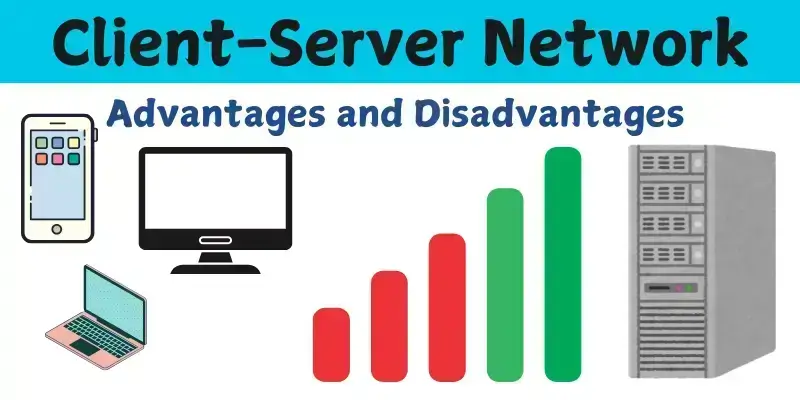Client-Server Network Advantages and Disadvantages
Published: February 21, 2025
Did you know that client-server networks are the backbone of modern businesses, handling everything from email services to financial transactions? These networks offer centralized control, making data management efficient. However, like any system, they have their limitations. In this post, we’ll explore the advantages and disadvantages of client-server networks, helping you understand whether this setup is proper for your needs.

What is a Client-Server Network?
Definition
A client-server network connects multiple client devices to a central server to access resources, data, or services. The server manages requests, ensuring efficient communication and control across the network.
Examples of Client-Server Network
- Email services (Gmail, Outlook, Yahoo Mail)
- Web browsing (Google, Facebook, Amazon)
- Online banking
- File sharing (Google Drive, Dropbox)
- Gaming servers (Fortnite, Call of Duty)
- Database management (SQL-based systems)
- Print servers in offices

Advantages and Disadvantages of Client-Server Network
The advantages and disadvantages of a Client-Server Network include benefits and limitations, making it essential to evaluate its impact before implementation.
Advantages of Client-Server Network

The benefits of a Client-Server Network make it a wise investment for modern systems.
- Centralized Management
- Improved Security
- Efficient Resource Sharing
- Scalability
- Faster Performance
- Backup and Data Recovery
- Remote Access
- Better Software and Application Management
- Reduces Redundancy
Discover how it boosts productivity and keeps things running smoothly.
1. Centralized Management
One of the most significant advantages of a client-server network is centralized management. The server controls all resources, applications, and security settings, making it easier for network administrators to monitor and maintain the system efficiently.
2. Improved Security
In a client-server network, security policies are managed centrally, reducing the risk of unauthorized access. Network administrators can apply firewalls, encryption, and user authentication protocols to protect sensitive data.
3. Efficient Resource Sharing
Servers store files, databases, and applications multiple clients can access simultaneously. This improves efficiency, reduces Redundancy, and ensures that users always have access to the latest version of files or applications.
4. Scalability
A client-server network can scale up or down based on the organization’s needs. Additional clients, storage, or processing power can be integrated without significantly affecting the overall performance.
5. Faster Performance
The network performs faster since powerful servers rather than individual clients handle processing and storage tasks. Clients can retrieve and process data without overloading their local machines.
6. Backup and Data Recovery
Data stored on a server can be backed up regularly, reducing the risk of data loss due to hardware failure, accidental deletion, or cyber threats. Network administrators can also restore data quickly in an emergency.
7. Remote Access
With a client-server network, users can access resources remotely. This is particularly useful for businesses with remote employees or multiple office locations, ensuring seamless connectivity.
8. Better Software and Application Management
Software updates and patches can be installed centrally on the server, eliminating the need to update each client device individually. It ensures that all clients have the latest security updates and software versions.
9. Reduces Redundancy
Since data is stored in a central location, multiple users can access the duplicate files, reducing Redundancy and improving collaboration within an organization.
10. Increased Reliability
Servers are designed for continuous operation, meaning they are more reliable than individual client computers. With backup systems and failover solutions, client-server networks offer higher uptime and reduced downtime.
Disadvantages of Client-Server Network

Before relying on the advantages of Client-Server Networks, it’s essential to be aware of these potential drawbacks.
- High Initial Cost
- Requires Skilled IT Personnel
- Dependency on a Central Server
- Security Vulnerabilities
- Network Congestion
- Limited Flexibility
- Risk of Data Loss
- Cost of Maintenance and Upgrades
- Potential Performance Bottlenecks
- Complexity in Setup and Management
Now, let’s examine the downsides and Disadvantages of Client-Server Networks and their effects on performance.
1. High Initial Cost
Setting up a client-server network requires a significant investment in hardware, software, and skilled personnel. Servers, networking equipment, and infrastructure can be expensive compared to peer-to-peer networks.
2. Requires Skilled IT Personnel
Maintaining a client-server network requires experienced IT professionals who can manage servers, troubleshoot issues, and ensure the network runs smoothly. Small businesses without an IT team may find it challenging.
3. Dependency on a Central Server
If the central server fails, all connected clients lose access to resources, disrupting business operations. Redundant backup servers and failover solutions can help mitigate this risk but add to the cost.
4. Security Vulnerabilities
Although client-server networks offer centralized security, they are also a prime target for cyberattacks. Hackers may attempt to breach the central server, gaining access to all connected clients and sensitive data.
5. Network Congestion
If multiple clients request data from the server simultaneously, it can cause network congestion, leading to slower response times. High traffic can overload the server, affecting performance.
6. Limited Flexibility
Client-server networks require predefined structures and protocols. Adding new users, devices, or applications may require reconfiguration, which can be time-consuming.
7. Risk of Data Loss
Despite backup solutions, server crashes, cyberattacks, or human errors can lead to data loss. Organizations must implement strong disaster recovery plans to minimize risk.
8. Cost of Maintenance and Upgrades
Regular maintenance, security updates, and hardware upgrades are necessary to keep the network running efficiently. These costs add up over time and require continuous investment.
9. Potential Performance Bottlenecks
If the server is not powerful enough to handle multiple client requests, it can become a bottleneck, slowing down performance. Upgrading to high-performance servers can be costly but necessary for large-scale operations.
10. Complexity in Setup and Management
Unlike peer-to-peer networks, a client-server network requires a complex setup, including server configuration, user authentication, and network monitoring. Organizations must invest time and resources to properly set up and maintain the system.
Is a Client-Server Network Right for You?
A peer-to-peer network may be a more straightforward and cost-effective solution if you run a small business or a home network with minimal data-sharing. However, a client-server network is a better option if you require centralized management, high security, and scalability.
Before choosing a network model, consider factors like budget, technical expertise, security requirements, and future growth. Investing in the proper infrastructure will ensure smooth operations and long-term benefits.
Final Thoughts
Understanding the advantages and disadvantages of client-server networks helps you make informed decisions. If security and efficiency are your priorities, a client-server network can be a wise investment. Before implementing it, assess your business size, technical requirements, and server capacity. Want to stay updated on the latest networking trends? Keep learning and experimenting!
Technology is constantly evolving—stay curious and embrace the future of networking!
Ignoring regular security updates can put your network at risk, so always prioritize maintenance.
FAQs About Advantages and Disadvantages of Client-Server Network
It depends on your needs. A client-server network is better for large organizations that need security and centralized control. However, a peer-to-peer network might be more straightforward and cheaper for small setups.
Not always. While it speeds up data access and management, too many requests can overload the server, slowing things down. A well-maintained server ensures smooth performance.
Yes! A client-server network can run on a local network (LAN) without needing the Internet. However, for cloud-based services, internet access is required.
Yes, mostly. Centralized security makes it harder for unauthorized access. However, the entire network is at risk if the primary server is hacked.
It depends on the scale. A client-server network needs a powerful server, which can be costly. But a basic setup can work fine for small businesses.
Clients can’t access data or services if the primary server goes down. That’s why businesses use backup servers or failover systems to prevent downtime.
No, each server has a limit. Too many clients can overload it, causing slow performance. Choosing the right server capacity is key.
No, small businesses with few devices might not need it. However, a client-server network is an excellent choice for companies with multiple users and shared data.
It can be done by beginners. However, it requires proper hardware, software configuration, and security measures. Hiring a network expert can make the process easier.
Yes! In addition to the initial setup, you may need upgrades, security updates, and regular maintenance. Ignoring these can lead to performance and security issues.





